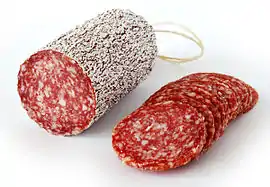Saucisson
Saucisson (French: [sosisɔ̃]), also saucisson sec or saucisse sèche, is a family of thick, dry-cured sausage-shaped charcuterie in French cuisine. Typically made of pork, or a mixture of pork and other meats, saucisson are a type of charcuterie similar to salami.[1]
 Sliced saucisson | |
| Alternative names | Saucisse sèche |
|---|---|
| Course | Sausage |
| Place of origin | France |
| Main ingredients | pork |

There is also a tradition of making saucisse sèche in western Switzerland,[2] the term saucisson being used only for sausages with interrupted maturation, therefore cooking sausages.[3]
Origin
Saucisson comes from the Latin salsus meaning salted. There are saucisson recipes dating from Roman times, and Gaulish recipes for dried pork.
The word saucisson first appeared in France in 1546 in the Tiers Livre of Rabelais.
Production
Stuffing
Saucisson stuffing is generally made of two-thirds to three-quarters lean meat and the rest fat (largely pork back-fat called bardière). The mixture is ground to different fineness depending on the type of saucisson and mixed with salt, sugar, spices, nitrites and/or saltpeter, and with fermenting bacteria. For instance, antilisterial strains of Lactobacillus sakei are used in Europe for the production of saucisson and can be used for the conservation of fresh meat.[4]
Some versions of saucisson also contain pepper seeds, garlic, mushrooms, bits of dried fruits or nuts (such as pistachios, figs, or olives), cheeses such as Roquefort, Laguiole, or alcohols such as wines or Génépi liquor.
See also
Further reading
References
- "Saucissons secs" (in French). Le Centre d'Information des Charcuteries-produits Traiteurs (Infocharcuteries). Archived from the original on 2013-09-23. Retrieved 2013-09-16.
- "Saucisses sèches valaisannes". Culinary Heritage of Switzerland. Retrieved 11 March 2023.
- "Saucisson neuchâtelois (IGP)". Culinary Heritage of Switzerland. Retrieved 12 March 2023.
Le saucisson neuchâtelois est un saucisson cru et fumé de porc. Il appartient à la famille des saucisses dites à maturation interrompue (que l'on pourrait faire sécher, mais qui sont en général cuites alors qu'elles sont encore moelleuses) typiques de la Suisse romande, qui comprend également les saucissons vaudois et fribourgeois, le boutefas, la longeole, la saucisse d'Ajoie, les saucisses aux choux et au foie.
[Saucisson neuchâtelois is a raw and smoked pork sausage. It belongs to the family of so-called interrupted maturation sausages (which could be dried, but which are generally cooked while still soft) typical of French-speaking Switzerland, which also includes Vaud and Fribourg sausages, Boutefas, Longeole, Saucisse d'Ajoie, cabbage and liver sausages.] - Bredholt, S.; Nesbakken, T.; Holck, A. (2001). "Industrial application of an antilisterial strain of Lactobacillus sakei as a protective culture and its effect on the sensory acceptability of cooked, sliced, vacuum-packaged meats". International Journal of Food Microbiology. 66 (3): 191–196. doi:10.1016/S0168-1605(00)00519-5. PMID 11428578.
